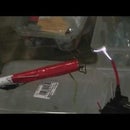Introduction: Infrared LED Box
My infrared LED box for use with my nightshot capable Sony Handycam, or an old camera such as a webcam with the infrared filter removed from in-front of the sensor will also allow you to capture infrared.
I don't recommend using a PP3 sized 9v battery as it won't last very long, instead use 6 AA's in series if there's room and the weight isn't an issue, alternatively use a lithium cell and DC-DC converter from ebay with constant current limiting to power the LEDs.
The LEDs were 200mW, 850nm, 10mm triple chipped infrared LEDs from ebay. Do not use 940nm LED's as the camera will not pick it up very well, better LEDs are available these days.
Supplies
Project box
Switch
Infrared LED's
Current limiting resistors OR DC-DC switching converter module with constant current limiting
Batteries
Battery pack holder
Wire + soldering iron and solder
Step 1: Led Series Resistor Calculation
The easiest way to calculate this is to google "LED series resistor calculator" and let the internet do all the calculations for you!
Resistor value = (Power supply voltage -Vdrop) /LED current
In my case that's a power supply voltage of 9v, dropping 4 1.5v LED's in series which makes for a Vdrop of 6v leaving 3v left over divided by .14 = 22 ohms.
So that's 9v-6v=3v/.14 amps=21.42 ohms, the nearest standard resistor value is 22 ohms so I'll pick that. It's safe to go up in resistance but not down unless the LEDs can take it.
Now there's the power dissipation to consider, its no good using a standard 1/4 watt resistor when its going to dissipate more power as the resistor will cook itself.
P=I^2R
The power dissipated as heat in a resistor depends on the current flowing through it, most online LED calculators will automatically calculate this for you.
In my case I've got 140mA flowing through a 22 ohm resistor, so that's 140mA x 140mA x 22 ohms = 431 Milliwatts. A half watt resistor would do although its good practice to go higher which in this case would be a 1 watt resistor.





